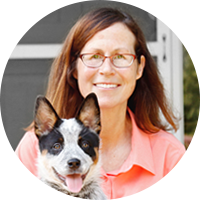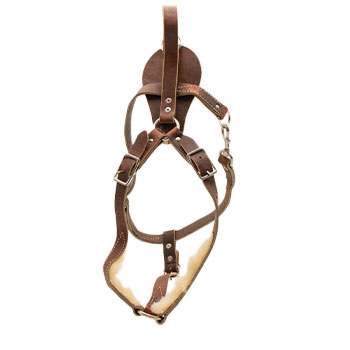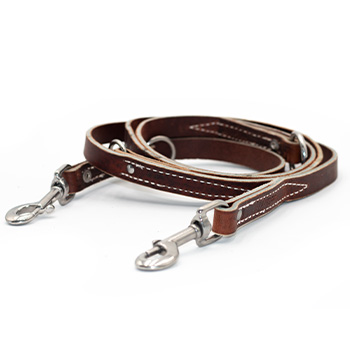May 18, 2011
We have a new patrol dog candidate. It has some serious issues with slick floors. What can we do?
Full Question:
Mr. Frawley,We have a problem with one of our new import dogs that we can't seem to figure out. I am a handler/instructor with the city of Melbourne, Florida K9 unit and am in the process of trying to get a new German Shepherd ready to work the road.
The dog is about 20 months old and has been in-country for about 4-6 months. He has lots of promise with nice prey drive and defense, some prior tracking experience and is very civil. The only snag we have come across in the K9 school is that the dog has a strong aversion to slick floors. I have come across this problem many times in the past and usually find that it is not a big deal once we get allot of associative work in getting the dog used to different environments, but this dog has become a real challenge. We are at a point in the school where, if we don't fix this its' going to stop us from continuing with an important part of training for police work. What we have done so far is walk the dog inside buildings in a non stress situation so that he can get used to the feel and what it takes to move around on the slick surface. We have also played tug-of-war and fetch with him inside the building when he appeared comfortable. This seemed to work and we thought we had the problem licked.
When we tried to conduct building search exercises and the stress level went up, the dog either wouldn't walk on the floor or he would concentrate on where he was walking and not on the task at hand. I attempted to overcome this by utilizing his prey drive and agitating him at the door where he could fire-up comfortably on rougher ground and have him bite at the entrance to the building. The dog either wouldn't engage or he would have a very weak bite. If the dog saw that he was going to hit the slick floor he would disengage.
After a number of these type of exercises didn't work, I put a piece of carpet over the door threshold and allowed the dog to bite where he could get some footing. While the dog was on the bite and the handler put back pressure on him he held tight even onto the slick floor, but when the back pressure was eased up he would loosen his bite or disengage. I tried this same routine and got onto the floor with the dog while he was on the bite as well with the same result.
We continue to try associating the dog with as many slick areas as we can and do not force him in when he doesn't want to go. After two weeks of building work mixed with other training we still have made very little headway.
I understand that these imports are kenneled pretty much their whole life and it is understandable that this is usually something we have to overcome when purchasing an import but I am at a loss for what to do next. Any help/insight that you could offer would be extremely usefully. It should be noted that this dogs' handler, even though he has been working a dog for approximately 10-11 years, is not the strongest and his timing and understanding of how these animals work is only fair. Anyway, thank you for your time.
Sincerely,
Howard

 Ed's Answer:
Ed's Answer:
I will tell you some things to try that may work. If they do not you will have to wash the dog out of the program. Bottom line is this should have been seen in the selection testing and the dog never should have been introduced into your program. This is not a kenneling issue - it's a nerve issue and 99% of the time it is genetic.
You need to have your bite work start outside the building. The dog needs to be fired up outside and then chase the helper into the building. In the beginning the bite is taken right inside the door (even if its not on slick floors). Then the bite is taken further and further inside the building. For the first week or so there does not have to be any search for the helper - this is problem solving. There should be no bark and hold. Just a bite and release of the sleeve and let the dog carry the sleeve out of the building.
The training actually involved 2 sleeves - initially the helper wears the first sleeve into the building. The second sleeve has already been hid inside the building.
When the dog goes in and bites and leaves with the sleeve - the handler OUTS the dog when it is outside (give it a few seconds of moving around to calm his nerves (don't let the dog put the sleeve on the ground and mouth it). The helper should step out of the building and the dog should be alerted on the guy. Usually this is enough to help with the OUT. When the dog is fired up again the helper runs into the building - gets the second sleeve and the dog is sent in for another bite. Again - no search - just a chase and bite.
You can work towards - not having the helper pre-stimulate the dog - just send him in for a bite (no B&H until this problem is fixed). The dog should go deeper and deeper into the building for a bite. Long hallways work great for this.
If 2 weeks or so of this kind of work will not bring this dog around - find him a new home and go get another dog. It sucks but this is how one learns to do a better job of selection testing - sounds like your vender screwed you if you ask me.
You may want to get my Building Search for Police Service Dogs. It's a very good video and deals with things like this.
You need to have your bite work start outside the building. The dog needs to be fired up outside and then chase the helper into the building. In the beginning the bite is taken right inside the door (even if its not on slick floors). Then the bite is taken further and further inside the building. For the first week or so there does not have to be any search for the helper - this is problem solving. There should be no bark and hold. Just a bite and release of the sleeve and let the dog carry the sleeve out of the building.
The training actually involved 2 sleeves - initially the helper wears the first sleeve into the building. The second sleeve has already been hid inside the building.
When the dog goes in and bites and leaves with the sleeve - the handler OUTS the dog when it is outside (give it a few seconds of moving around to calm his nerves (don't let the dog put the sleeve on the ground and mouth it). The helper should step out of the building and the dog should be alerted on the guy. Usually this is enough to help with the OUT. When the dog is fired up again the helper runs into the building - gets the second sleeve and the dog is sent in for another bite. Again - no search - just a chase and bite.
You can work towards - not having the helper pre-stimulate the dog - just send him in for a bite (no B&H until this problem is fixed). The dog should go deeper and deeper into the building for a bite. Long hallways work great for this.
If 2 weeks or so of this kind of work will not bring this dog around - find him a new home and go get another dog. It sucks but this is how one learns to do a better job of selection testing - sounds like your vender screwed you if you ask me.
You may want to get my Building Search for Police Service Dogs. It's a very good video and deals with things like this.
100% (1 out of 1)
respondents found this answer helpful


Can't find what you're looking for?





